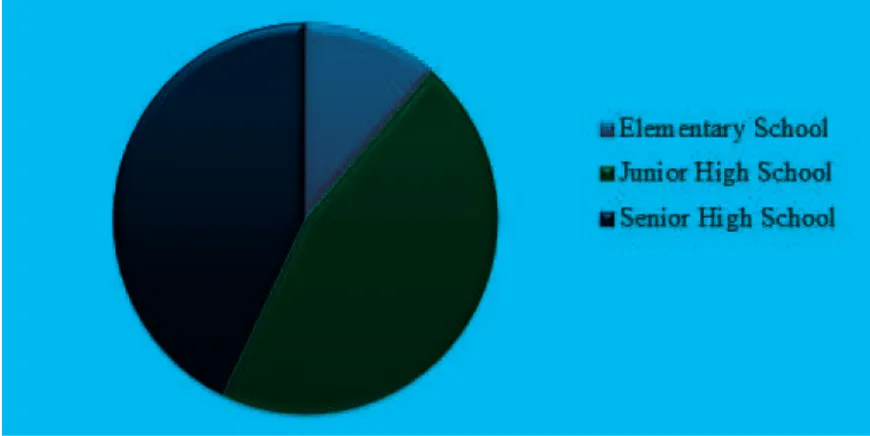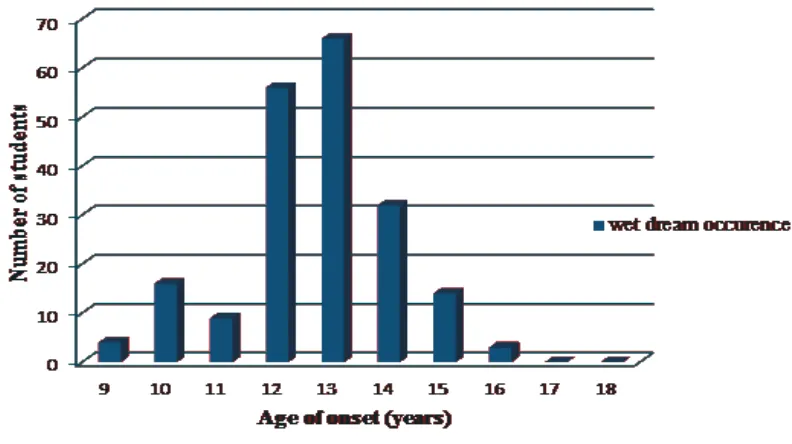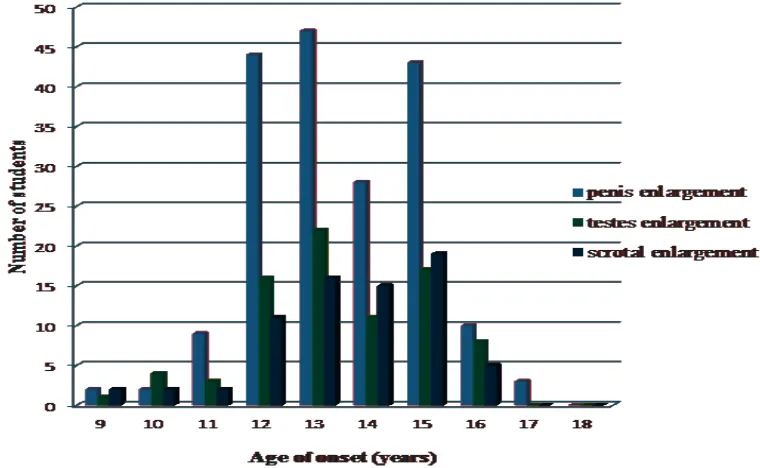The Distribution of Pubertal Age among Male School Students in
Jatinangor District from April to June 2013
Karthik Yogaswaran,1 Anggraini Widjajakusuma,2 Juliati3
1Faculty of Medicine Universitas Padjadjaran, 2Department of Epidemiology and Biostatistics
Faculty of Medicine Universitas Padjadjaran, 3Department of Physiology Faculty of Medicine
Universitas Padjadjaran
Abstract
Background: Puberty is important and exciting lifetime changes in an individual. Many new changes are experienced during puberty, such as physically, mentally, and emotionally. Currently, young males worldwide have different onset of pubertal age. Many factors may result in this change of pubertal age. The exact pubertal age was still unknown due to less study conducted previously. Therefore, the aim of this study was to identify the distribution of pubertal age among male school students in Jatinangor.
Methods: A descriptive study was conducted from April to June 2013. A secondary data were obtained from the Jatinangor Cohort Study, from the Department of Epidemiology and Biostatistics, Faculty of Medicine, Universitas Padjadjaran. The samples were taken via cluster random sampling from 48 schools around Jatinangor. Randomization was conducted and a total of 219 male students were finally obtained from the overall data which had at least single onset of pubertal changes. This presents a response rate of 82.33%.
Results: The earliest onset of pubertal age was identified as 9 years old and the oldest onset was 18 years
old. The majority onset of pubertal age ranged from 12 to 15 years old with average mean of 13 years. Voice changes were identified as the early sign of puberty among males.
Conclusions: Majority of the students undergo puberty at age 13 which is earlier compared to previous studies. Thus, this study indicates decreasing in onset of pubertal age among male school students in Jatinangor. [AMJ.2016;3(1):6–11]
Keywords: Jatinangor, male school students, pubertal age, puberty
Correspondence: Karthik Yogaswaran, Faculty of Medicine, Universitas Padjadjaran, Jalan Raya Bandung-Sumedang Km.21, Jatinangor, Sumedang, Indonesia, Phone: +6283821350838, Email: irthik_sujo22@yahoo.com
Introduction
Changing trends occurring between childhood and adulthood, in the transitional phase of growth and development varies in every individual. This period is known as pubertal phase.1 The development of physical growth
is known as adolescence stage which roughly ranges from 11–19 years old.2 According
to American Academy of Pediatrics (AAP), currently, young males start puberty much more earlier compared to previous decades.1
Now, males begin puberty six months to two years earlier. Some males undergo precocious puberty (PP), as the development of pubertal changes, at an age younger than the accepted lower limits for age of onset of puberty.3
Thus, United State boys reach puberty between ages of 9–10, compared to 25 years
ago where the first sign of puberty occurs at
ages of 11 years or more.4 Black American
boys start showing pubertal changes around age 9.1 years while white and Hispanic boys undergo changes just after turning 10.5 Similar
trends towards earlier puberty in boys have been seen in studies in Europe.4 However, in
Asian countries, the mean age for pubertal among males is 15 years old.6 Several studies
conducted stated that fewer data are available on the age and pattern of pubertal development
in boys. This reflects less cultural awareness
of male pubertal development.7 Besides, the
Methods
The type of study conducted was descriptive study. This study was carried out from April to June 2013. A secondary data were obtained from the Jatinangor Cohort Study from the Department of Epidemiology and Biostatistics, Faculty of Medicine, Universitas Padjadjaran. Jatinangor Cohort Study comprised of reproductive health among school students in Jatinangor District and was approved by Health Research Ethics Committee. The samples were taken via cluster random sampling from 48 Elementary School (Sekolah Dasar, SD), Junior High School (Sekolah Menengah Pertama, SMP) and Senior High School (Sekolah Menengah Atas, SMA) around Jatinangor, which made up a total of 7542 male students.
The six schools selected were SD Negeri Cibeusi, SD Negeri Cikopo II, SMP Al-Masoem, SMP PGRI, SMA PGRI and SMA Negeri Jatinangor which had a total of 1250 male students. Randomization was conducted by the Jatinangor Cohort Study team by only selecting Class IV–VI male students from Elementary School, Class VII–IX male students from Junior High School and Class X–XII male students from Senior High School which had a total of 266 male students. These students were given
an informed consent form to be filled by their
parents or guardians. Questionnaire forms which comprises of onset of pubertal age measured by secondary sexual characteristics were given to the students. The questionnaire
was validated by the Jatinangor Cohort team.
A total of 219 male students were finally
obtained from the whole data which had at least single onset of pubertal changes. This presents a response rate of 82.33%. All the data collected from the questionnaires were composed into Statistical Product and Service Solutions (SPSS) software version 15. The distribution of pubertal age among male students was analyzed. All the results were presented in suitable graphs.
Results
A total of 219 male students with onset of pubertal changes were divided according to their level of education. The highest number of onset of pubertal agewas experienced among Junior High School students while the lowest number was from Elementary School students (Figure 1).
The earliest age for voice changes among male students was at age 9 years old with a total of 6 students and the oldest occurs at age 18 with only 1 student. The highest number experiencing onset of voice changes was 53 students at age 12 years old. The age range for majority voice changes was 12–14 years old (Figure 2).
The onset of wet dream occurrence among male students began at age 9 years with a total of 4 students. There are 3 students with onset at age 16 years, while the highest number experiencing onset of wet dream as 66
students at age 13 years old. The age range for majority wet dream occurrence was at 12–14 years old (Figure 3).
Moustache and pubic hair showed earlier onset of growth at age 10 years old, while beard and axillary hair started growing at age
12 years. The highest onset of hair growth varied. The highest number experiencing onset of pubic hair growth was 56 students at age 13 years old. Meanwhile, for onset of moustache and axillary hair growth, the highest number experiencing was at age 15 years, with 34
Figure 2 Number of Students with Onset of Voice Changes according to Age
students and 25 students respectively. Onset of beard growth had the highest number at age 16 years with 27 students. Thus, the majority age range for sexual hair growth among Jatinangor boys was 12–15 years (Figure 4).
The earliest age for penis, scrotal, and testes enlargement among male students was at age 9 years old. Penis and testes enlargement had the same highest number experiencing its onset which was at age 13 with 47 students
Figure 4 Number of Students with Onset of Sexual Hair Growth according to Age
and 22 students respectively. Meanwhile, the highest number experiencing onset of scrotal enlargementwas 19 students at age 15 years old. The majority age range for the enlargement was 12–15 years old (Figure 5).
Discussion
The study to find the distribution of pubertal
age among the 219 students was conducted. The students were divided according to the onset of pubertal age corresponding with their pubertal changes. The pubertal changes that were taken in count were voice changes, moustache growth, beard growth, axillary hair growth, pubic hair growth, penis enlargement, scrotal enlargement, testes enlargement, and occurrence of wet dream. The range of pubertal age was based on the earliest onset of pubertal changes and the latest onset. The
majority age range was also identified from
this study.
The result showed that the earliest onset of pubertal changes was at age 9 years old and the oldest onset occured at age 18 years old. This showed a wide range of pubertal onset among Jatinangor males. In Elementary School, there were 25 students with onset of pubertal changes and among them, the highest onset was seen in occurrence of wet dreams. Fourteen students experienced these changes, while voice changes took second highest with 11 students experiencing it. Meanwhile, among Junior High School students, pubertal changes occured in 100 students. Wet dreams occured mostly in all students, followed by voice changes and pubic hair growth. Finally, there were 94 students obtained from Senior High Schools with onset of pubertal changes. Wet dreams, voice changes, and pubic hair growth still remained the most frequent secondary sexual changes with onset of puberty. However, more students experienced voice changes prior to wet dream occurrence, resulting in voice changes as early sign of puberty in Jatinangor male school students.
The majority onset of pubertal changes occured at age 12–15 years old. This showed a clear decrease in the onset of pubertal age. Previous study showed that the onset of puberty among Asian males is 15 years old.6 Now, males began puberty six months to two years earlier. Similar trends towards earlier puberty in boys have been seen in studies in Europe. United State boys reach puberty between ages of 9–10, compared to previous
years where average boys undergo the first
sign of puberty around 11 years old or more.4,7
Voice changes had the highest number of students experiencing earlier onset which is at age 12 years old. Study showed that generally aboy’s voice starts to change somewhere between ages of 11–15 years.2 Thus, for males
in Jatinangor, the voice changed at age 12–14 years old. Voice changes is a result of hormonal changes, the increase of testosterone level during puberty.6
The secondary sexual characteristic is due to the result from the stimulation of gonads by pituitary gonadotropin. Testes enlargement are relatively constant untill age 11 years then the testicular enlargement begins.8 Similar
trend was seen among males in Jatinangor. This sudden increment could be the result of the hormonal changes that takes place in the male students.2 Therefore, certain studies
classify the increase in testicular size as a
definite sign of puberty.8,9 The distribution of
hair growth is also similar to other secondary sexual characteristics. The majority age range for onset of hair growth is also 12–15 years old. Pubic hair has the earliest growth at age 12 just after increase in the testicular volume. This showed the change in testosterone production in a male undergoing pubertal age.8 Occurrence of wet dreams is also strongly related to change in body hormonal level.
The factor that causes this decreasing trend of pubertal age is still unknown. Although puberty is mostly due to the change in body hormonal level, but current lifestyle and environmental factor could be causes of early onset of puberty among younger generations.10 Current lifestyle which includes
the dietary pattern on an individual might be a predisposing factor to the decrease in onset of puberty in males. Huge amount of fat intake is said to fasten the body metabolism to result in an early onset of puberty.4
In conclusion, the pubertal age in Jatinangor is around age 9–18 years old with the majority age range of 12–15 years old. The overall mean age for onset of puberty is 13 years old. The sign of puberty that appears early is voice changes followed by wet dreams and pubic hair growth.
References
1. Abbassi V. Growth and normal puberty. Pediatrics.1998;102(2 Pt 3):507–11.
2. Elizabeth ARE, Seth D. Pubertal development: correspondence between hormonal and physical development. Child Dev. 2009;80(2):327–37.
3. Carel JC, Leger J. Precocious puberty. N Engl J Med. 2008;358:2366–77.
4. Herman-Giddens ME, Steffes J, Harris D, Slora E, Hussey M, Dowshen SA, et al. Secondary sexual characteristics in boys: data from the Pediatric Research
in Office Settings Network. Pediatrics.
2012;130(5):e1058–68.
5. Harris P. Boys are reaching puberty earlier. New York: The Guardian; 2012 [cited 2012 October 20]; Available from: http://www. guardian.co.uk.
6. Xenos P, Sulistinah A, Lin HS, Luis PK, Podhisita C, Raymundo C, et al. Delayed Asian transitions to adulthood: a perspective from national youth surveys. Asian Population Studies. 2006;2(2):149– 83.
7. Euling SY, Lee PA, Selevan SG, Juul A, Sorensen T, Dunkel L, et al. Examination of US puberty-timing data from 1940 to 1994 for secular trends. Pediatrics. 2008;121 Suppl 3:S172–91.
8. Fujienda K. Pubertal development in Japanese boys. Clin Pediatr Endocrinol. 1993;2(Suppl 3):7–14.
9. Okuno A. Physical growth and hormonal changes in late childhood and early adolescence. Clin Pediatr Endocrinol. 1993;2(Suppl 3):1–6.


